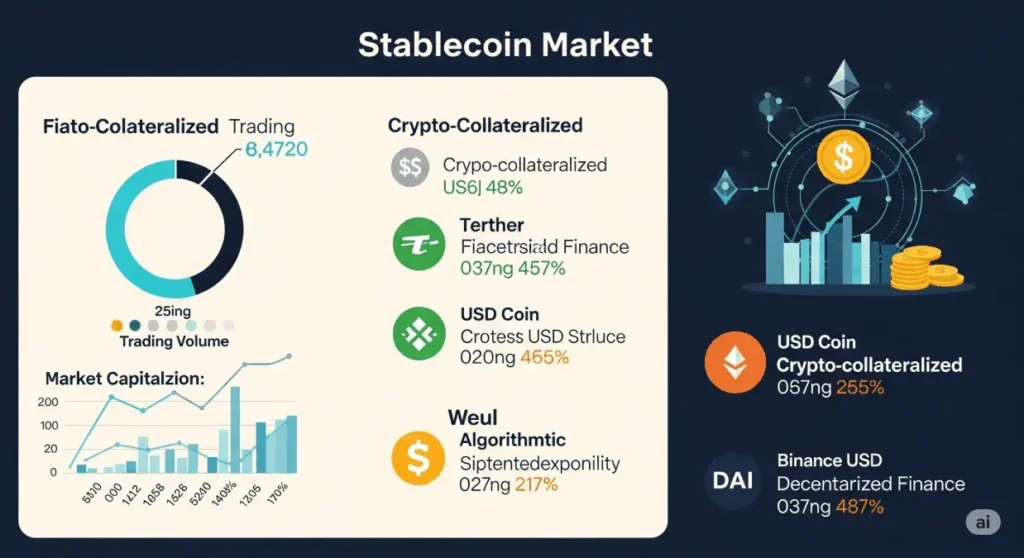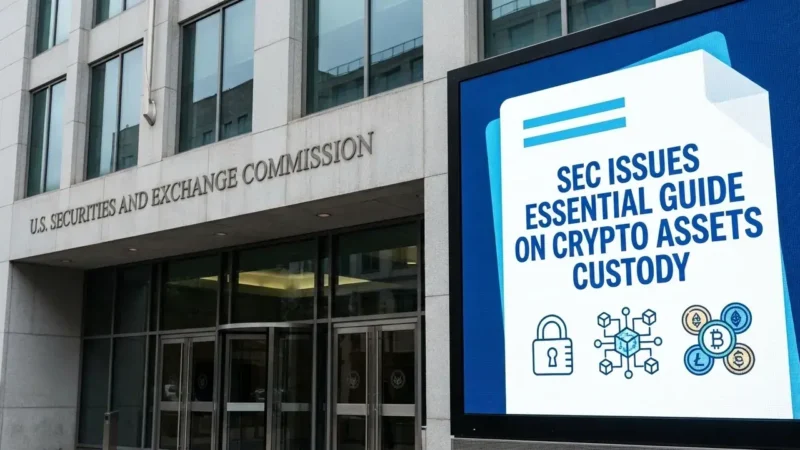Stablecoin Market: A Crossroads of Projections and Innovation

The burgeoning stablecoin market finds itself at a critical juncture, marked by vastly different forecasts from leading financial institutions. On one side, JPMorgan offers a cautious outlook, projecting the global stablecoin market will only reach $500 billion by 2028. This stands in stark contrast to Standard Chartered’s far more ambitious estimate of $2 trillion for the same period. This significant divergence underscores a fundamental disagreement on the pace of stablecoin maturation and their eventual integration into the broader financial ecosystem.
The Conservative Lens: JPMorgan’s Skepticism
JPMorgan’s conservative stance stems from a critical assessment of stablecoins’ current utility. The banking giant points to a perceived limitation in real-world use cases, noting that only a meager 6% of stablecoin transactions involve actual payments. Their analysis suggests that the overwhelming majority of demand—approximately 88%—remains crypto-native, primarily confined to activities such as trading, decentralized finance (DeFi), and treasury management within the digital asset sphere.
Furthermore, JPMorgan highlights inherent frictions that dampen widespread adoption. Stablecoins, in their current form, often do not offer competitive yield returns compared to traditional savings vehicles, and the processes for converting stablecoins back into fiat currency can be both costly and cumbersome. This “added friction,” combined with their existing reliance on established banking infrastructure for reserve management, fuels JPMorgan’s skepticism that stablecoins can replace traditional financial systems in the near term. The bank views stablecoins not as a substitute for traditional banks or widely adopted centralized digital wallets like Alipay or WeChat Pay, but rather as a tool that largely serves a niche within the crypto economy. Compounding this cautious view are concerns over the fragmented global regulatory landscape and the increasing push by various nations to develop their own central bank digital currencies (CBDCs), which could potentially compete with private stablecoins.
The Ambitious Horizon: Standard Chartered’s Optimism
Standard Chartered, conversely, paints a far more optimistic picture for the stablecoin market. Their $2 trillion projection is largely predicated on the expectation of significant regulatory clarity, particularly the passage of the GENIUS Act in the United States. This legislation, officially known as the Guiding and Establishing National Innovation for U.S. Stablecoins Act, is seen as a pivotal development that could legitimize the sector, foster innovation, and attract substantial institutional capital.
The GENIUS Act, which passed the U.S. Senate in June 2025 and is now headed to the House, aims to establish a comprehensive federal framework for payment stablecoins. Key provisions of the Act include restricting stablecoin issuance to federally regulated banks, qualified nonbank entities, and state-regulated issuers under specific conditions. It mandates full 1:1 collateralization, requiring stablecoins to be backed by U.S. dollars, short-term Treasuries, or other highly liquid assets. Issuers would also face stringent requirements for monthly public disclosures of reserve composition and annual independent audits, alongside obligations for Anti-Money Laundering (AML) compliance and consumer protection. Critically, the Act explicitly seeks to prevent payment stablecoins from being classified as securities or deposit liabilities, offering a clearer legal footing. Standard Chartered believes that such a robust and clear regulatory environment could significantly de-risk the stablecoin space for institutional investors, leading to a substantial increase in stablecoin supply and consequently, a surge in demand for the underlying U.S. Treasury bonds that often collateralize USD-pegged stablecoins. This, in turn, could reinforce USD hegemony in the digital realm.
Beyond Crypto: Expanding Real-World Use Cases
While JPMorgan points to limited real-world payments, the stablecoin market is actively evolving to address this very challenge. Beyond their established roles in trading, DeFi, and treasury management, stablecoins are increasingly finding traction in a variety of practical applications that extend their utility far into mainstream finance:
- Instant Cross-Border Remittances: Traditional remittance services are often slow and expensive, with fees ranging from 3-8%. Stablecoins can reduce these costs to less than 1% with near-instant settlement. Major players like MoneyGram are already integrating stablecoins to streamline transfers, particularly in corridors like the U.S.-Latin America route. This eliminates the need for pre-funding accounts across multiple countries and allows recipients greater control over their funds.
- Global Payroll: Paying remote teams across borders involves complex banking requirements and high fees. Stablecoins enable instant, cost-effective payments to a global workforce, reducing settlement times from days to mere seconds.
- E-commerce and Merchant Payments: Stablecoins offer a stable medium of exchange for online businesses, allowing for real-time settlements without the volatility of other cryptocurrencies or the delays of traditional bank transfers. This enables smoother transactions for digital goods, services, and even physical products.
- Financial Inclusion: For billions globally who are unbanked or underbanked, stablecoins provide a crucial pathway to digital financial services. In regions with high inflation or limited banking infrastructure, stablecoins can act as a stable store of value and enable basic financial transactions using just a smartphone.
- Programmable Treasury and B2B Transactions: Stablecoins can facilitate automated payments based on predefined conditions through smart contracts, enabling “programmable treasury.” This is transformative for B2B transactions, allowing for instant and automated transfers when conditions like goods delivery are met.
- Crowdfunding and Security Deposits: Stablecoins can eliminate payment processing fees in crowdfunding, ensuring creators receive funds instantly and globally. For real estate and PropTech, stablecoins can transform idle security deposits into yield-generating assets, offering transparent and automated management.
Innovators Driving Adoption: Circle, Tether, and PayPal USD
The push for real-world usability is being spearheaded by major stablecoin issuers and new entrants.
- Circle (USDC): As one of the largest stablecoin issuers, Circle has been instrumental in advocating for regulatory clarity and expanding USDC’s reach. Their Cross-Chain Transfer Protocol (CCTP) allows for seamless native USDC transfers across various blockchains, reducing reliance on third-party bridges and enhancing liquidity. Circle’s focus on compliance and enterprise-grade solutions positions USDC as a preferred choice for businesses and institutions looking to integrate digital dollars.
- Tether (USDT): Despite regulatory scrutiny in the past, Tether’s USDT remains the largest stablecoin by market capitalization and a dominant force in crypto trading. Tether continues to expand its presence across multiple blockchains, supporting diverse use cases for liquidity provision and cross-border value transfer.
- PayPal USD (PYUSD): PayPal’s entry into the stablecoin market with PYUSD signifies a major step towards mainstream adoption. Launched in partnership with Paxos Trust Company, PYUSD is designed to bridge traditional finance with the crypto economy. PayPal has aggressively pursued real-world utility for PYUSD, including:
- Integration with Xoom: Allowing users to fund international remittances with PYUSD, significantly reducing fees.
- Expansion to Stellar and Solana: Recognizing the need for fast and low-cost transactions, PayPal is making PYUSD available on the Stellar network (pending regulatory approval) and has already integrated with Solana. This greatly enhances its utility for everyday payments, micro-financing, and cross-border transactions by leveraging these networks’ speed and low fees.
- Yield Offerings: PayPal has announced a 3.7% annual yield on PYUSD balances held in PayPal or Venmo wallets for U.S. users, a strategy to incentivize adoption by blending earning potential with spending utility.
- Merchant Integration: PayPal plans to integrate PYUSD into 20 million merchant networks by late 2025, targeting small businesses and aiming to revolutionize payment economics by cutting transaction costs.
Technical Foundations: Solana and Layer 2s
The underlying blockchain infrastructure plays a crucial role in enabling stablecoin efficiency and scalability for real-world use. Platforms like Solana and the broader ecosystem of Layer 2 solutions are dramatically lowering costs and improving transaction speeds.
- Solana’s Advantages: Solana is celebrated for its high throughput and incredibly low transaction fees. With theoretical speeds of up to 65,000 transactions per second (TPS) and average fees around $0.02, Solana offers near-instant finality, making it highly suitable for high-frequency use cases like payments, gaming, and decentralized exchanges. Its unique Proof of History (PoH) consensus mechanism combined with Proof of Stake (PoS) allows for this rapid processing. The presence of native USDC and USDT on Solana, along with seamless cross-chain capabilities via Circle’s CCTP, further solidifies its position as a key network for stablecoin movement.
- Layer 2 Solutions: For blockchains like Ethereum, which has a more limited native TPS, Layer 2 solutions (e.g., Arbitrum, Optimism, zkSync) are essential for scaling. These networks process transactions off the main chain and then batch them for settlement on Layer 1, significantly increasing throughput and reducing gas fees. This scaling strategy ensures that even high-demand stablecoin transactions remain affordable and efficient, expanding their potential reach beyond the core crypto user base. The ongoing development of bespoke Layer 2 solutions, some specifically for networks like Solana to address occasional congestion, further demonstrates the industry’s commitment to optimizing performance for stablecoin utility.
CBDCs: Complement or Competition?
The rise of central bank digital currencies (CBDCs) introduces another dynamic to the future of the stablecoin market. Some experts suggest that CBDCs pose a threat to private stablecoins, particularly as governments aim to maintain monetary control and financial stability in an increasingly digital world. However, the development and intent behind CBDCs vary widely across nations.
- China’s e-CNY: China is arguably the most advanced in its CBDC rollout. The e-CNY (digital yuan) was conceived primarily as a domestic retail CBDC for everyday payments, though China has expressed a strong willingness to explore its internationalization. The e-CNY features a tiered anonymity system, allowing for small, anonymous transactions while requiring full Know Your Customer (KYC) for larger amounts. It also offers offline payment capabilities (tap-to-pay) and aims to enhance financial inclusion in rural areas. From China’s perspective, the e-CNY is a strategic asset, enabling smart monetary policy and potentially reducing reliance on foreign financial systems.
- European Central Bank’s Digital Euro: The ECB is proceeding more cautiously with the digital euro, currently in a preparatory phase. Key considerations for the digital euro include prioritizing privacy and optionality for users, as well as addressing concerns from commercial banks about potential disintermediation (i.e., people moving large sums from bank accounts to CBDC wallets). Discussions around holding limits (e.g., between €1,000 and €10,000) reflect efforts to balance convenience with financial stability. The digital euro also aims to reduce reliance on foreign-owned payment systems like Visa and Mastercard.
- Israel and Russia: Countries like Israel and Russia are also rolling out CBDCs in phases, often with limited scope. Russia’s digital ruble project, for instance, has progressed rapidly with real-world testing and is intended as a retail CBDC to integrate into everyday transactions. A notable motivation for Russia is the ability to conduct cross-border payments without relying on the SWIFT international payment network, from which many Russian banks were disconnected. However, challenges such as public skepticism over state surveillance and integration costs for banks persist.
While CBDCs offer benefits like enhanced financial inclusion, reduced transaction costs, and potentially more direct monetary policy tools for central banks, they fundamentally differ from private stablecoins. CBDCs are central bank liabilities, typically designed to be a direct claim on the central bank and backed by the full faith and credit of the government. This gives them legal tender status within their respective jurisdictions.
The Unique Promise of Private Stablecoins
Despite the emergence of CBDCs, private stablecoin issuers operate globally with remarkable agility and speed. The competitive advantage of stablecoins lies in their potential for “programmable money,” open finance, and decentralized innovation.
- Programmable Money: While CBDCs might enable programmable payments (e.g., automatic transfers when certain conditions are met), stablecoins, particularly those built on public blockchains, can embody true programmable money. This means the money itself can have built-in rules, enabling more complex automated financial operations without intermediaries.
- Open Finance: Stablecoins are foundational to the open finance movement, allowing for permissionless innovation and broader access to financial services without the need for traditional bank accounts. This fosters a more inclusive and interconnected global financial system.
- Decentralized Innovation: Stablecoins can leverage the decentralized nature of blockchain technology to offer greater transparency and resilience compared to centralized systems. This allows for rapid development of new financial products and services, fostering a dynamic and competitive environment.
Stay informed, read the latest crypto news in real time!
The flexibility, transparency, and cross-border efficiency offered by private stablecoins suggest that they are unlikely to be entirely replaced by state-run alternatives. Instead, they could evolve to complement CBDCs, serving distinct but interconnected roles within a hybrid digital financial landscape. Stablecoins, with their global reach and agility, are uniquely positioned to outperform CBDCs in areas requiring seamless cross-border value transfer and innovative financial applications over the long term. The ongoing expansion of the stablecoin market will ultimately be shaped by both technological advancements and the evolving regulatory frameworks that seek to balance innovation with financial stability and consumer protection.





One thought on “Stablecoin Market: A Crossroads of Projections and Innovation”